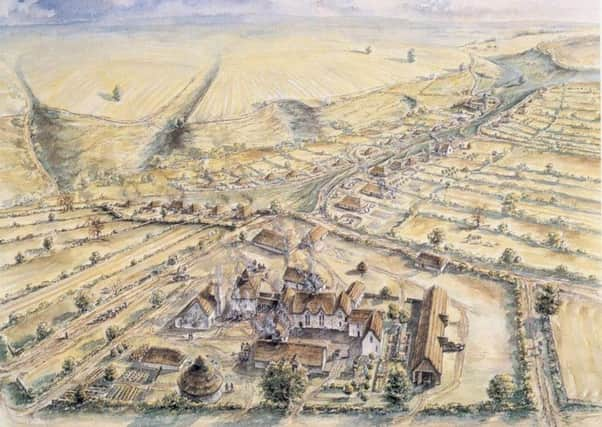Exhibit of the Week: Historic importance of the medieval village of Wharram Percy


The first documentary reference to the village appears in the late 11th century Domesday Book, where it is known as Warron. In the 13th century the village came into the possession of the Percy family and from that point onwards has been known as Wharram Percy. The village, like so many others, declined in the mid-14th century due to the ravages of the Black Death. However, by 1368 some 30 houses are known to be occupied perhaps indicating some degree of recovery. The settlement again suffered a period of reverse during the 15th century and finally by the early 16th century, the last remaining inhabitants were evicted and the arable fields turned over to sheep pasturage. Only the parish church, the vicarage and one farmstead remained in use after this date. The vicarage was demolished in the 1830s and the farmhouse in the 1840s (the outbuildings of the farm survived and were converted into the row of cottages which remain on the site today). The graveyard continued to receive burials up to the beginning of the 20th century however the church itself was ruinous by 1950.
There are somewhere in the region of 3,000 deserted medieval village sites in England and Wharram Percy, whilst being a well preserved example, is by no means exceptional. What makes Wharram stand out in terms of its national significance stems from the results of nearly forty years of archaeological investigations at the site. Excavations commenced in 1950 under the direction of Maurice Beresford who initially planned a small scale intervention to look at selected medieval buildings. These limited investigations demonstrated the archaeological potential of the site and led to the founding of the Wharram Research Project in 1952. From the 1950s until 1990 fieldwork on site continued, until approximately 10% of the area of the site had been excavated. This included a major open area excavation at the church, the post-medieval farm buildings and two medieval houses at the west end of the village. The result is that Wharram Percy is the best understood site of its type, certainly in England and perhaps Europe. The ruined church and village earthworks point to the development of the settlement and how it operated, both socially and economically and the archaeological investigations tell us something about the lives of the people who at one time or other inhabited the site.
Advertisement
Hide AdAdvertisement
Hide AdThe archaeologists, like the former residents of the village, have now moved on and we are left once again with open fields. Standing on the site of Wharram Percy today we get a sense of tranquillity and quietness, but it is worth taking the time to reflect on the history of the place and remember that here lived people whose lives were played out in a similar way to our own. They worked to bring up their families, laughed and enjoyed each other’s company, fell out at times, celebrated weddings, Christmas and Easter the rich commotion of village life. This was swept away due to circumstances over which they had no control, but we can, with a little effort, just about recapture that time in our imagination.